Basu P. Biomass Gasification and Pyrolysis: Practical Design and Theory
Подождите немного. Документ загружается.

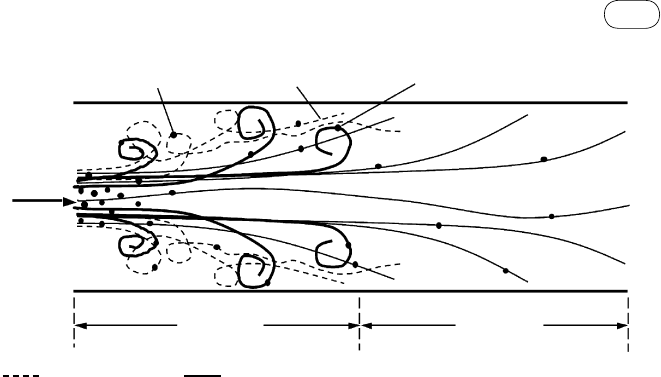
187
6.4 Entrained-Flow Gasifiers
Entrained-flow gasifier design may be classified into two broad groups:
(1) the top-fed downflow (used by GE Energy and Siemens SFG), shown in
Figure 6.16; and (2) the side-fed upflow (used by Koppers-Totzek, the Shell
gasification process, Prenflo, and the Lurgi multipurpose), shown in Figure 6.17.
6.4.1 top-Fed Gasifier
Top-fed gasifiers use a vertically cylindrical reactor vessel, into which pulver-
ized fuel (biomass or coal) and gasifying agent(s) are conveyed by oxygen and
injected from the top. This vessel resembles a vertical furnace with a downward
burner (Figure 6.16). The fuel and the gasifying agent(s) are injected into the
reactor through a jet that generally sits at the reactor’s middle section.
The fuel gasifier (SFG) process of Siemens uses a top-fired reactor design,
in which the reactants are introduced through the single centrally mounted
burner. This has several advantages. First, it is of an axisymmetrical construc-
tion, reducing equipment costs; second, the flow of reactant occurs from a
single burner, reducing the number of burners to be controlled; finally, the
product gas and the slag flow in the same direction, which reduces any potential
blockage in a slag trap (Higman and van der Burgt, 2008, p. 132).
6.4.2 side-Fed Gasifier
In side-fed gasifiers, powdered fuel is injected through horizontal nozzles set
opposite each other in the reactor’s lower section (Figure 6.17). Jets of fuel and
gasifying agents form a stirred-tank reactor characterized by a high degree of
mixing. The product gas moves upward and exits through the top. Because of
the high oxygen availability in this mixing zone, rapid exothermic reactions
take place, raising the gas temperature to well above the ash-melting point
Fuel particle
Fuel particle path Gas particle
Pulverized
fuel + O
2
Combustion
zone
fuel particle path gas path
Gasification
zone
FIGure 6.15 Simplified sketch of gas–solid flow in an entrained-flow gasifier.
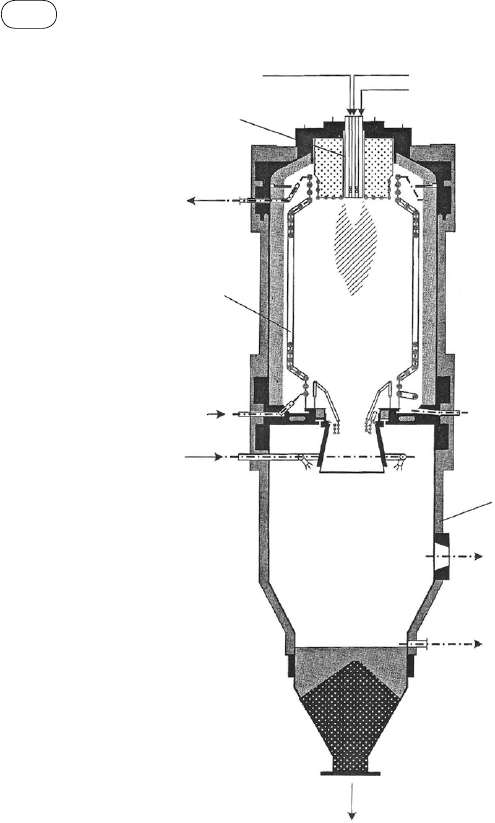
188
chapter
|
6 Design of Biomass Gasifiers
(>1400 °C). Thus, the ash, instead of traveling up, is separated in this zone as
slag from the fuel, and drained. Some gasifier designs (e.g., E-gas, MHI, Eagle)
inject additional fuel further downstream from the main reaction zone.
The Koppers-Totzek atmospheric pressure gasifier also uses side feeding.
It consists of two side-mounted burners where a mixture of coal and oxygen
is injected. The gas leaves from the top of the gasifier at temperatures
around 1500 °C and is quenched with water downstream. The reactor has a
steam jacket to protect its shell from high temperatures (Higman and van der
Burgt, 2008, p. 129).
Fuel
Burner
Pressure
water outlet
Cooling screen
Cooling jacket
Oxygen
Gas to pilot burner
Gas outlet
Water
overflow
Granulated slag
Pressure
water inlet
Quench
water
FIGure 6.16 A schematic of a top-fed downflow entrained-flow gasifier.
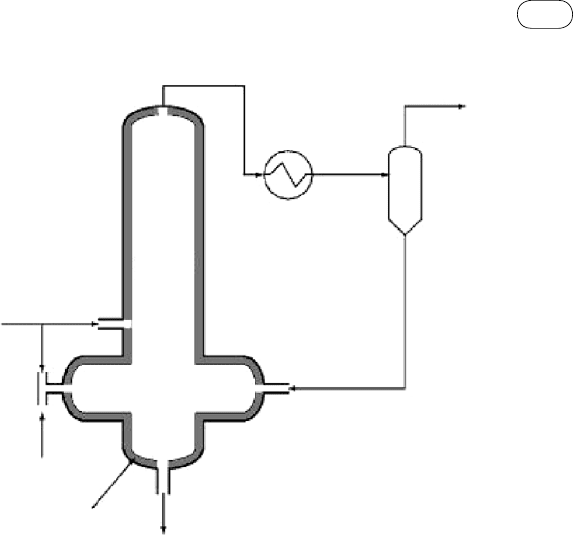
189
6.4 Entrained-Flow Gasifiers
The E-gas gasifier is a side-fed two-stage entrained-flow slagging gasifier
with a coal–water slurry feed. It is designed to use sub-bituminous coal (Figure
6.17). The coal slurry is fed at the nonslagging stage, where the upflowing gas
heats it. Thus, the gas exits at a lower temperature and then passes through a
fire-tube boiler and is filtered in a hot candle filter. The char, separated out by
the filter, is taken back to the slagging zone. The slag is quenched in a water
bath at the bottom of the slagging reactor.
6.4.3 advantages of entrained-Flow Gasifiers
Entrained-flow gasifiers have several advantages over other types:
Low tar production
A range of acceptable feed
Ash produced as slag
High-pressure, high-temperature operation
Very high conversion of carbon
Low methane content well suited for synthetic gas production
Coal
slurry
Second
stage
First stage
Fire tube
boiler
Char
recycle
Syngas to
treating
Hot candle
filter
Oxygen
Refractory
Slag
by-product
Slag/water
slurry
FIGure 6.17 A schematic of a side-fed entrained-flow gasifier.
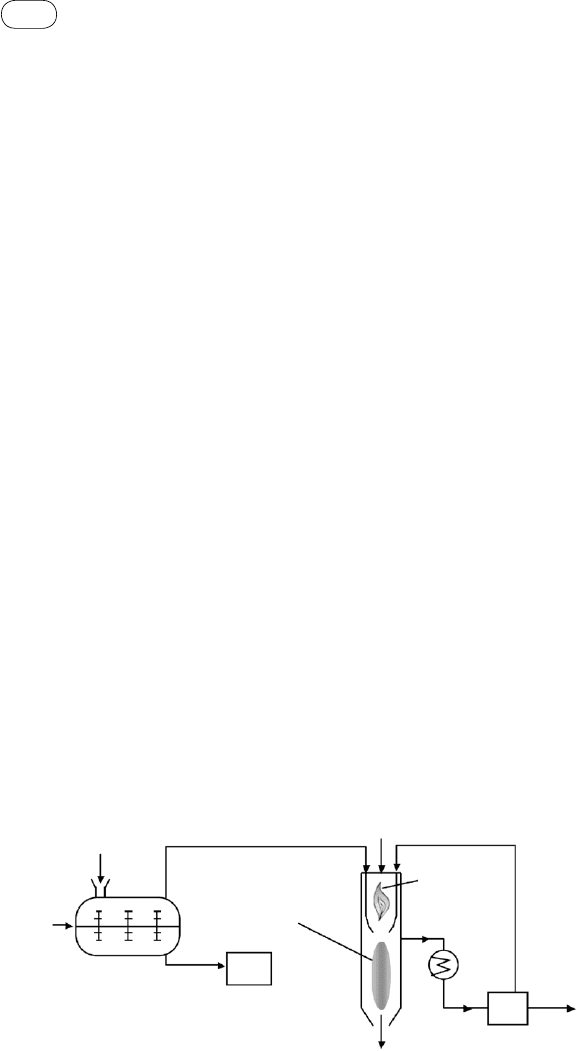
190
chapter
|
6 Design of Biomass Gasifiers
6.4.4 entrained-Flow Gasification of Biomass
For thermal gasification of the refractory components of biomass (those diffi-
cult to gasify) such as lignin, the minimum temperature requirement is similar
to that for coal (~900 °C) (Higman and van de Burgt, 2008, p. 147). Entrained-
flow gasification of biomass is therefore rather limited and has not been seen
on a commercial scale for the following reasons:
The residence time in the reactor is very short. For the reactions to complete,
the biomass particles must be finely ground. Being fibrous, biomass cannot
be pulverized easily.
Molten ash from biomass is highly aggressive because of its alkali com-
pounds and can corrode the gasifier’s refractory or metal lining.
Given these shortcomings, entrained-flow gasifiers are not popular for biomass.
However, there is at least one successful entrained-flow biomass gasifier,
known as the Choren process.
Choren Process
The Choren entrained-flow biomass gasifier is comprised of three stages (Figure
6.18). The first stage receives biomass in a horizontal stirred-type low-temper-
ature reactor for pregasification at 400 to 500 °C in a limited supply of air. This
produces solid char and a tar-rich volatile product. The latter flows into the
second chamber (stage 2), an entrained-flow combustor where oxygen and the
product gas from the first stage are injected downward into the reactor. Com-
bustion raises the temperature to 1300 to 1500 °C and completely cracks the
tar. The hot combustion product flows into the third chamber (stage 3), where
the char is gasified.
The solid char received from the first stage is pulverized and fed into the
third stage of the Choren process. It is gasified in the hot gasification medium
produced in the second stage. Endothermic gasification reactions reduce the
Biomass
Air
Pyrolysis gas + tar
Oxygen
Ash + char
Cooler
Ash
Deduster
Product gas
Combustion
(stage 2)
Gasifier
(stage 3)
Pulverizer
Low-temperature
gasifier (stage 1)
FIGure 6.18 Choren process. The biomass is gasified in an entrained-flow gasifier, facilitated
by a rotary-type partial gasifier (stage 1).
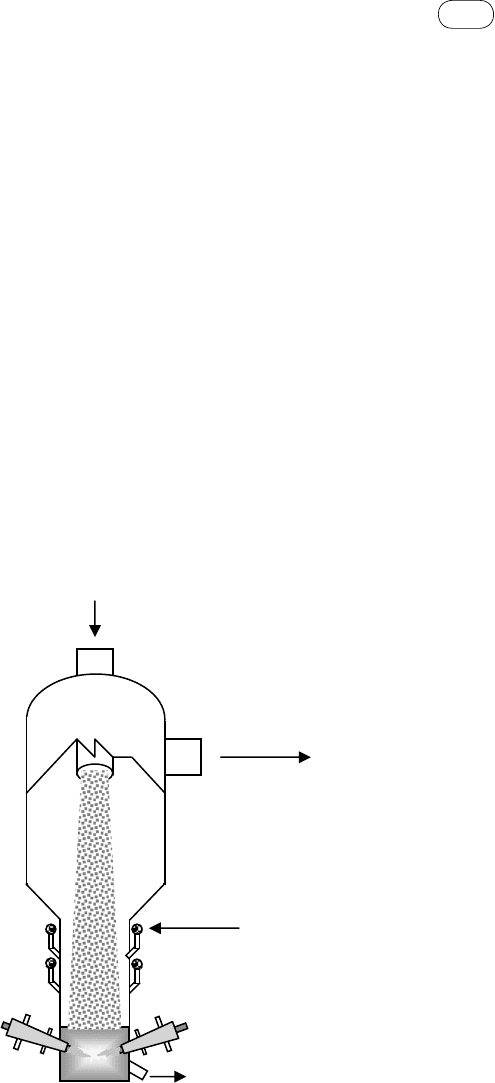
191
6.5 Plasma Gasification
temperature to about 800 °C. Char and ash from the product gas are separated
and recycled into the second-stage combustor. The ash melts at the high tem-
perature in the combustor and is drained from the bottom. Now molten, the ash
freezes, forming a layer on the membrane wall that protects the wall against
the corrosive action of fresh molten biomass ash. The product gas is processed
downstream for Fisher-Tropsch synthesis or other applications.
6.5 PlasMa GasIFIcatIon
In plasma gasification, high-temperature plasma helps gasify biomass hydro-
carbons. It is especially suitable for MSW and other waste products. This
process may also be called “plasma pyrolysis” because it essentially involves
thermal disintegration of carbonaceous material into fragments of compounds
in an oxygen-starved environment. The heart of the process is a plasma gun,
where an intense electric arc is created between two electrodes spaced apart in
a closed vessel through which an inert gas is passed (Figure 6.19).
Though the temperature of the arc is extremely high (~13,000 °C), the
temperature downstream, where waste products are brought in contact with it,
is much lower (2700–4500 °C). The downstream temperature is still sufficiently
high, however, to pyrolyze complex hydrocarbons into simple gases such as
CO and H
2
. Simultaneously, all inorganic components (e.g., glass, metals,
Plasma torch
Biomass in
Raw syngas
Air or oxygen feed
Slag
FIGure 6.19 Plasma gasification of solid waste.

192
chapter
|
6 Design of Biomass Gasifiers
silicates, heavy metals) are fused into a volcanic-type lava, which after cooling
forms a basaltic slag. The product gas leaves the gasifier at very high tempera-
tures (1000–1200 °C).
A typical plasma reactor provides a relatively long residence time for the
gas in the gasifier. This and the high temperature cause the tar products to be
cracked and harmful products like dioxin and furan to be destroyed.
Owing to the high reactor temperature and the presence of chlorine in
wastes, the life of the reactor liner is an issue. However, an attractive feature
is that plasma gasification is relatively insensitive to the quality of the feed-
stock. This is the result of an independent energy source run by electricity
instead of partial combustion of the gasification product.
6.6 Process desIGn
The design of a gasifier involves both process and hardware. The process
design gives the type and yield of the product, operating conditions, and the
basic size of the reactor. The hardware design involves structural and mechani-
cal components, such as grate, main reactor body, insulation, cyclone, and
others, that are specific to the reactor type. This section focuses on gasifier
process design.
6.6.1 design specification
For any design, specification of the plant is very important. The input includes
the specification of the fuel, gasification medium, and product gas. A typical
fuel specification will include proximate and ultimate analysis, operating tem-
peratures, and ash properties. The specification of the gasifying medium is
based on the selection of steam, oxygen, and/or air and their proportions.
These parameters could influence the design of the gasifier, as follows:
The desired heating value of the product gas dictates the choice of gasifica-
tion medium. Table 6.4 gives typical ranges of heating value for different
mediums.
TABLE 6.4 LHV of Product Gas Ranges and Choice
of Gasifying Medium
Gasification Medium
Range of Heating Value of Product
Gas (MJ/Nm
3
)
Air gasification 4–7
Steam gasification 10–18
Oxygen gasification 12–28

193
6.6 Process Design
Hydrogen can be maximized with steam, but if it is not a priority, oxygen
or air is a better option, as it reduces the energy used in generating steam
and the energy lost through unutilized steam.
If nitrogen in the product gas is not acceptable, air cannot be chosen.
Capital cost is lower for air, followed by steam. A much larger investment
is needed for an oxygen plant, which also consumes a large amount of
auxiliary power.
Equivalence ratio
For the product gas, the specification includes:
Desired gas composition
Desired heating value
Desired production rate (Nm
3
/s or MWth produced)
Yield of the product gas per unit fuel consumed
Required power output of the gasifier, Q
The design outputs of process design include geometry and operating and per-
formance parameters.
Basic size includes reactor configuration, cross-section area, and height
(hardware design). Important operating parameters are: (1) reactor temperature;
(2) preheat temperature of the steam, air, or oxygen; and (3) amount (i.e., steam/
biomass ratio) and relative proportion of the gasifying medium (i.e., steam/
oxygen ratio). Performance parameters of a gasifier include carbon conversion
and cold-gas efficiency.
A typical process design starts with a mass balance followed by an energy
balance. The following subsections describe the calculation procedures for
these.
6.6.2 Mass Balance
Basic mass and energy balance is common to all types of gasifiers. It involves
calculations for product gas flow and fuel feed rate.
Product Gas Flow Rate
The gasifier’s required power output, Q (MWth), is an important input param-
eter specified by the client. Based on this, the designer makes a preliminary
estimation of the amount of fuel to be fed into the gasifier and the amount of
gasifying medium. The volume flow rate of the product gas, V
g
(Nm
3
/s), from
its desired lower heating value, LHV
g
(MJ/Nm
3
), is found by
V
Q
LHV
g
g
= Nm s
3
(6.5)
The net heating value or lower heating value (LHV) can be calculated
from its composition. The composition may be predicted by the equilibrium

194
chapter
|
6 Design of Biomass Gasifiers
calculations, described later, or by sophisticated kinetic modeling of the gas-
ifier, as discussed in Chapter 5. In the absence of these, a reasonable guess can
be made. either from published data on similar fuels in similar gasification
conditions or from the designer’s experience.
For example, for air-blown fluidized-bed biomass gasifiers, the LHV is in
the range 3.5 to 6 MJ/Nm
3
(Enden and Lora, 2004). For oxygen gasification,
it is in the range 10 to 15
MJ/Nm
3
(Ciferno and Marano, 2002). So, for an air-
blown gasifier, we start with a value of 5
MJ/Nm
3
as a reasonable guess (Quaak
et
al., 1999).
Fuel Feed Rate
To find the biomass feed rate, M
f
, the required power output is divided by the
LHV of the biomass (LHV
bm
) and by the gasifier efficiency, η
gef
.
M
Q
LHV
f
bm gef
=
η
(6.6)
The LHV may be related to the higher heating value (HHV) and its hydrogen
and moisture contents (Quaak et
al., 1999) as
LHV HHV H M
bm daf daf daf
= − × − ×20 300 2 260, , (6.7)
Here, H
daf
is the hydrogen mass fraction in the fuel, M
daf
is the moisture mass
fraction, and HHV
daf
is the HHV in kJ/kg on a moisture-ash-free basis. By using
the definition of these one can relate the HHV on moisture-ash-free basis to
that on only dry-basis value as
HHV HHV
M
ASH M
daf d
=
−
− −
1
1
(6.8)
where the subscripts d and daf refer to dry and moisture-ash-free basis, respec-
tively; M is the moisture fraction; and ASH is the ash fraction in fuel on a
raw-fuel basis.
On a dry basis, the HHV, HHV
d
, is typically in the range 18 to 21 MJ/kg
(Van Loo and Koppejan, 2003, p. 48). It may be calculated from the ultimate
analysis for the biomass using the following equation (Van Loo and Koppejan,
2003, p. 29):
HHV C H S N
O ASH
d
= + + −
− −
0 3491 1 1783 0 1005 0 0151
0 1034 0 0211
. . . .
. .
(6.9)
where C, H, S, N, O, and ASH are the mass fraction of carbon, hydrogen, sulfur,
nitrogen, oxygen, and ash in the fuel on a dry basis.
Flow Rate of Gasifiying Medium
The amount of gasification medium has a major influence on yield and com-
position of the product gas. This section discusses methods for choosing that
amount.

195
6.6 Process Design
Air
The theoretical air requirement for complete combustion of a unit mass of a
fuel, m
th
, is an important parameter. It is known as the stoichiometric air
requirement. Its calculation is shown in Eq. 2.34. For an air-blown gasifier
operating, the amount of air required, M
a
, for gasification of unit mass of
biomass is found by multiplying it by another parameter ER:
M m ER
a th
=
(6.10)
Here, ER is the equivalence ratio.
For a fuel feed rate of M
f
, the air requirement of the gasifier, M
fa
, is
M m ER M
fa th f
= ⋅ (6.11)
For a biomass gasifier, 0.25 may be taken as a first-guess value for the equiva-
lence ratio, ER. A more detailed discussion of this is presented next.
Equivalence Ratio
The equivalence ratio is an important gasifier design
parameter. It is the ratio of the actual air–fuel ratio to the stoichiometric air–fuel
ratio. This term is generally used for air-deficient situations, such as those found
in a gasifier.
ER EA
gasification
<
( )
= = >
( )
1 0 1 0. .
Actual air
Stoichiometric air
ccombustion
(6.12)
where EA is the excess air coefficient.
In a combustor, the amount of air supplied is determined by the stoichio-
metric (or theoretical) amount of air and its excess air coefficient. In a
gasifier, the air supply is only a fraction of the stoichiometric amount. The
stoichiometric amount of air may be calculated based on the ultimate analysis
of the fuel.
The equivalence ratio, ER, dictates the performance of the gasifier. For
example, pyrolysis takes place in the absence of air and hence the ER is zero;
for gasification of biomass, it lies between 0.2 and 0.3.
Downdraft gasifiers give the best yield for ER, 0.25 (Reed and Das, 1988,
p. 25). With a lower ER value, the char is not fully converted into gases. Some
units deliberately operate with a low ER to maximize their charcoal production.
A lower ER gives rise to higher tar production, however, so updraft gasifiers,
which typically operate with an ER of less than 0.25, have higher tar content.
With an ER above 0.25, some product gases are also burnt, increasing the
temperature.
The quality of gas obtained from a gasifier strongly depends on the ER
value, which must be significantly below 1.0 to ensure that the fuel is gasified
rather than combusted. However, an excessively low ER value (<0.2) results in
several problems, including incomplete gasification, excessive char formation,
and a low heating value of the product gas. On the other hand, too high an
ER (>0.4) results in excessive formation of products of complete combustion,

196
chapter
|
6 Design of Biomass Gasifiers
such as CO
2
and H
2
O, at the expense of desirable products, such as CO and H
2
.
This causes a decrease in the heating value of the gas. In practical gasification
systems, the ER value is normally maintained within the range of 0.20 to 0.30.
Figure 6.20 shows the variation in carbon conversion efficiency of a circulating
fluidized-bed gasifier for wood dust against the equivalence ratio. The efficiency
increases with ER and then it starts declining. The optimum value here is 0.26,
but it may change depending on many factors.
The bed temperature of a fluidized-bed gasifier increases with the ER
because the higher the amount of air, the greater the extent of the combustion
reaction and the higher the amount of heat released (Figure 6.21). Example 6.1
illustrates the calculation procedure for ER.
Oxygen
Oxygen is used primarily to provide the thermal energy needed for the endo-
thermic gasification reactions. The bulk of this heat is generated through the
following partial and/or complete oxidation reactions of carbon:
C O CO kJ mol+ → −0 5 111
2
. (6.13)
C O CO kJ mol+ → −
2 2
394 (6.14)
It can be seen that for the oxidation of 1
mol of carbon to CO
2
, the oxygen
requirement is (2 × 16)/12 = 2.66
mol, while that for carbon to CO is (16/12)
= 1.33
mol. Thus, the reaction in Eq. (6.13) is more likely to take place in
oxygen-deficient regions.
Besides supplying the energy for the endothermic gasification reactions, the
gasifier must provide energy to raise the feed and gasification medium to the
reaction temperature, as well as to compensate for the heat lost to the reactor
walls. For a self-sustained gasifier, part of the chemical energy in the biomass
Equivalence ratio
0.15
Carbon conversion efficiency (%)
0.2 0.25 0.3
100
90
80
70
60
50
40
FIGure 6.20 Effect of equivalence ratio on carbon conversion in a fluidized-bed gasifier.
